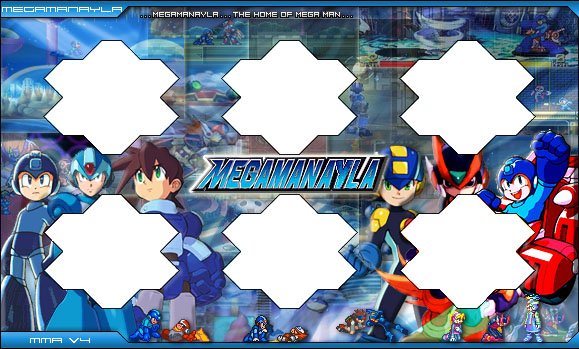|
This
file shows details and explanation about Mega Man: Upon a Star. |
The Mega Man cartoon from the early '90s did
not hold up well. I think we all can agree on that. That doesn't stop me from
holding on to those dear memories of waking up at seven on Saturday mornings to
catch the latest adventures of 'roid-abuser Mega Man and his April O'Neil
jumpsuit-wearing, vacuum arm-toting sister Roll. So what if it deviated from the
source material a bit? After the
mighty
green midget from Captain N: The Game Master, I don't think anyone
was complaining.
Some years ago, I was browsing the aisles of Best Buy and spotted the series on
DVD. I was planning on picking up the first season when I noticed another DVD
right beside it titled Mega Man: Upon a Star, a properly proportioned
Mega Man greeting me on the cover. Curious, I bought that instead, unaware of
the treat in store for me.
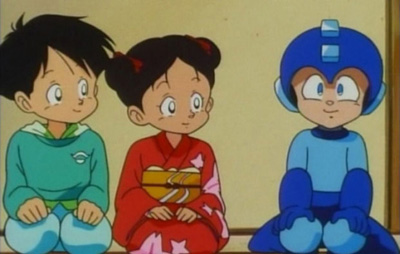
I later discovered that prior to the Ruby-Spears production that we've come to
love (hate?), a pilot was pitched featuring character designs far more faithful
to their game counterparts. In 1993, a three-episode Japanese OVA based on this
pilot was produced by Capcom but was never aired. It was decided that the show
should be retooled into something a little edgier for American audiences, so the
OVA remained MIA until its Japanese video release in 2002 and its American debut
three years later. That OVA is Mega Man: Upon a Star.
Firing up the disc, it's hard not to get pumped
during the opening montage as Mega Man lays the smack down on all the Mega
Man 5 Robot Masters while the credits roll and '80s synth rock blares.
However, something quickly turned my excitement into apprehension:
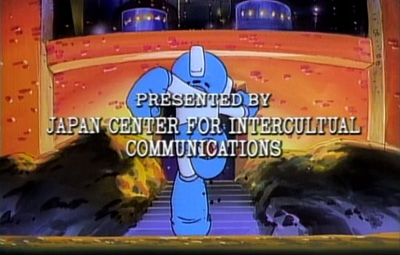
"Presented by the Japan Center for Intercultural Communications"? Aw crap,
it's an educational film! Alright, let's assess the damage, shall we?
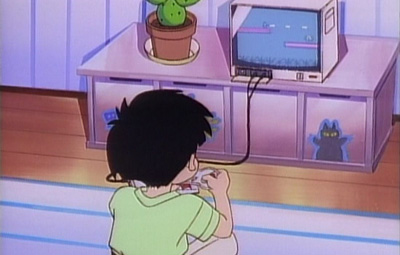
Our story begins with Japanese fifth-grader Yuuta Kobayashi who is up way past
his bedtime playing his American copy of Mega Man 5 (more on that later).
As he's about to deliver the final blow to Dr. Wily, he nods off to sleep,
pausing the game before collapsing on the floor. With Mega Man rendered
immobile, Dr. Wily jumps out of the TV with aspirations to take over the real
world. When Yuuta wakes up the following morning and unpauses the game, Mega Man
jumps out as well and asks Yuuta for help tracking down Wily's location. In
order to accomplish so, Yuuta and his sister Akane must first teach Mega Man
about Japanese geography and customs.
What.
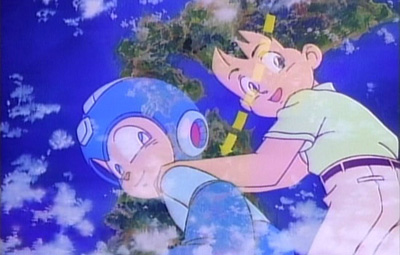
You can't help but laugh at the inanity of it all. Wily is building a doomsday
device that is certain to end all of humanity and Mega Man is busy sightseeing
in Okinawa. Armed with the knowledge that Japanese children receive money on New
Year's Day and attend cram school that often ends late in the evening, Mega Man
is prepared to stare cold, metal death in the eye.
Thankfully, the show never dives into CBS territory and is perfectly content
with sprinkling random facts here and there. At its heart, it's an action show
that offers an introduction to Japanese lifestyles as an added bonus. Actually,
I think the intention was to trick parents into thinking their kids were
watching an instructional video.
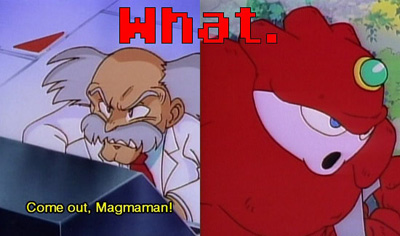
In true Wily fashion, each episode sees him plotting to turn an element of
Japanese cultural significance against the population. In the first episode,
Wily uses the dormant power of Mount Fuji to construct an army of Magma Men
(totally unrelated to the Mega Man 9 namesake... or is it?). In the
second episode, Wily steals Dr. Light's time machine in order to gather a large
collection of meteors and set them to drop on a specific day in the future,
Tanabata, the
Japanese star festival, when Japanese people look to the sky to wish upon
the stars (say, that's where the DVD title comes from!). In the final episode,
Wily studies the nature of the typhoons that assault Japan every year in order
to construct a typhoon generator with the destructive force to level the entire
country.
Meanwhile, Mega Man's short attention span proves to be his greatest nemesis: "I
must find out when Dr. Wily will make his next move! There's no time to lose...
oh, what are those, Yuuta?
Koinobori
raised in honor of Children's Day? How interesting! Tell me more!"
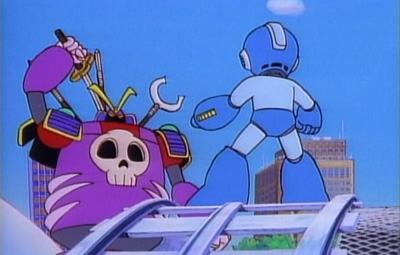
All joking aside, there is a lot for long-time Mega Man fans to legitimately
enjoy. The art and animation are quite decent, remaining faithful to the
official game artwork and Keiji Inafune's original designs. Well, scratch that.
The first two episodes look fantastic, but the third looks to have been farmed
out to the
3rd string backup animation team. Seeing as how the OVA was the precursor to
the Ruby-Spears production, it's only natural that the Ocean Group voice acting
team would be on board for both. The only actors who voiced the same characters
in both shows were
Scott McNeil as Dr. Wily and
Jim Byrnes as Dr. Light, but that was enough for yours truly to totally geek
out.
There's also a Japanese-language track option with a curious surprise of its
own. I mentioned above that when we first meet Yuuta he is playing an American
copy of Mega Man 5. The title screen is clearly visible at one point:
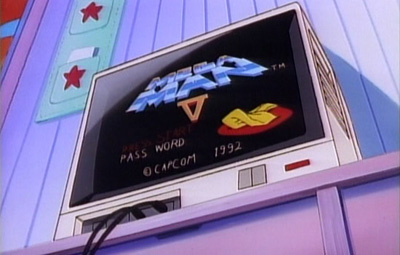
Why would a Japanese child not be playing a Japanese copy of the game? Perhaps
his father is an American soldier stationed in the country? No, he is not.
Throughout the entire first episode, all the characters are referenced by their
Western names, i.e. "Mega Man" instead of "Rockman" and "Proto Man" instead of
"Blues." For episodes two and three, everything switches back to normal. I
understand that the nature of the show as a foreigner's introduction to Japanese
culture would require tailoring towards that particular audience, but since the
program was to be released both locally and abroad, why would the Japanese
version commit to the same changes? And why weren't the changes consistent
across all three episodes? Chew on that for a while.
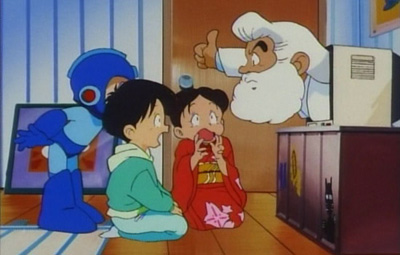
In the end, the show is pandering. It's silly. Yeah, it's a kids' show. But you
know what? I actually wound up liking it despite its faults. This is totally
something I could have seen myself enjoying as a child. And truthfully? As
forced and pace-shattering as those "The More You Know" moments are, it's an
effective way of dropping knowledge on kids while still offering the
pulse-pounding action that you've come to expect on a Saturday morning with a
bowl of Lucky Charms in your lap. The Ruby-Spears show was great for what it
was, but it would have been interesting to say the least if the infotainment
angle had been explored further.
I recommend trying to score a copy of
Mega Man: Upon a Star off of Amazon if you want to have a good laugh
or two. Come for the fan service, stay for the grade-school level culture
lessons!




